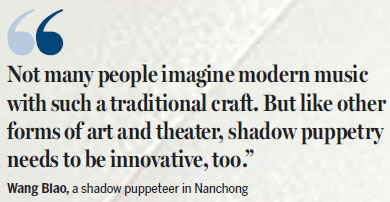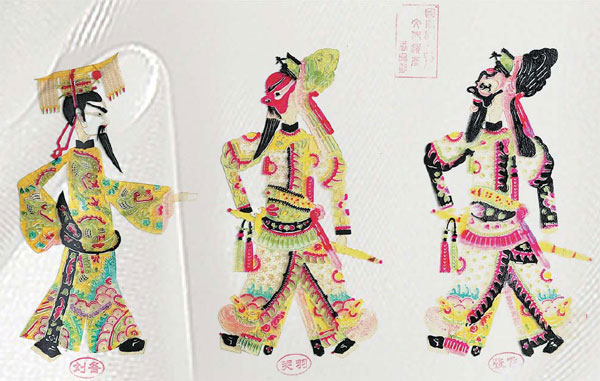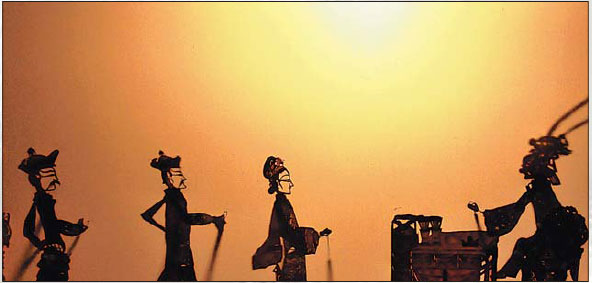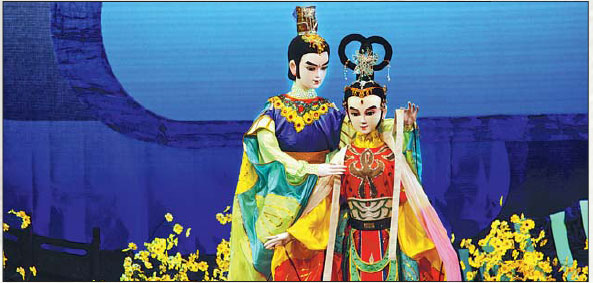Traditional shadow puppeteers carry tradition forward
Jia swings her arms, shakes her waist and bounces on her legs to a hip-hop beat as Wang Biao gleefully directs her movements. Using three wooden sticks to hold up and move the two-dimensional traditional shadow puppet behind an illuminated curtain for the room to see, Wang has Jia bringing smiles and laughter to a crowd of onlookers.
"Not many people imagine modern music with such a traditional craft," Wang said. "But like other forms of art and theater, shadow puppetry needs to be innovative, too."
Wang, now in his 60s, is one of several shadow puppeteers teaming up with the local governments in Nanchong, Sichuan province to inspire future generations to embrace the celebrated ancient craft.
Founded during the Han Dynasty (206 BC-AD 220) over 2,000 years ago and popularized as far back as the Tang and Song dynasties from the early 600s to late 1,200s, shadow puppetry is one of many Chinese cultural treasures threatened to become extinct, he said.
As younger generations pursue more technologically based careers and lifestyles, fewer people are taking time to learn about and engage in shadow puppetry.
That's where Jia comes in. The puppet, made of cow hide that's skinned, carved and dyed, is part of a new project designed to connect with Chinese youth. Instead of traditional shadow puppet clothing, which includes a mix of hanfu and other classical garb, Jia wears a yellow shirt, pink pants and cowboy boots. Instead of moving to the sound of a yangqin, pipa or percussion instrument, she dances to synthesized electronic music.

Thanks to a combined 80 million yuan ($11.4 million) in grants from the city and provincial governments, the public is getting an up-close view of Jia and her creator for the first time.
The Wang Piying Folk Culture Industrial Park, founded earlier this decade, opened to the public in 2018 and is set to become a full-scale museum by summer 2020.
The 42,000 square-foot facility lets visitors enjoy Wang's shadow puppetry performances free of charge and provides a behind-the-scenes view as the longtime puppeteer shears the cow hides that will become his future puppets.
A room where Wang, his brother Wang Feng and a half dozen other workers dry and cure the hide, is also on display.
"It's as unique and intimate of a setting for shadow puppetry as you can find," Wang said.
The government grants have also provided for the nationally renowned shadow puppeteer to bring on student apprentices to learn the traditional craft. Wang said he currently instructs about 20 combined local high school and university students, some of whom frequent the park for months at a time learning the different aspects of shadow puppet creation, display and performance.
Students also have a hand in designing and crafting the dozens of shadow puppets on display at the industrial park, Wang said. Puppets that don't see the main stage are put up for sale in a gift shop.
The price - 188 yuan for simple designs like birds and statues to nearly 1,000 yuan for more elaborate puppets such as humans - isn't bad considering a single puppet can take up to 70 working hours to complete.
In Nanbu, 25 kilometers south of Wang's park, married couple Yang Hongfu and Wang Chunhong bring viewers a more traditional shadow puppetry experience.
Their booming voices, amplified by microphones connected to a new, state-of-the-art sound system, can be heard on the main road below from the third floor of a municipal building where they perform. Sitting next to the couple, three middle-aged musicians produce a melodious soundbed on the erhu and a pair of percussion instruments.
Yang, 56, and his wife have also reaped the benefits of added municipal dollars for their preservation efforts.
He said the speaker system draws curious viewers who now hear the music on the road into the free, open-to-the-public building and upstairs to the room where the couple performs their shadow puppet shows as they sing.
Government funds also pay for the duo to travel to Nanchong villages and rural areas, where they provide shows for primary school students whose entertainment options are limited. In such areas, shadow puppetry also has a hopeful future, Yang said.
"There's a reason it's been around this long," he said. "Thankfully, we can help the next generation discover its beauty."
chriskudialis@chinadaily.com.cn


|
Shadow puppet shows in Langzhong city and Nanbu county, as well as the big puppet show in Shunqing district, are seen as core part of Nanchong’s intangible culture heritage. Photos provided to China Daily |
(China Daily 09/17/2019 page26)















